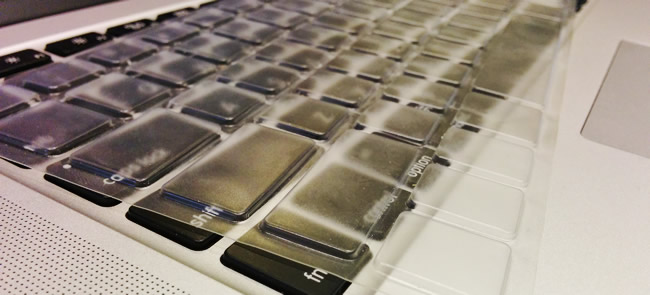I use protective covers on all of my electronics. I recently purchased the Moshi ClearGuard keyboard cover for my MacBook Pro. In addition to protecting against spills, it also helps keep the keys free of grease. I have oily fingers which translates to shiny keys within months without a cover. This was a must have product for me.
Pros
Easy to Install
Compared to other keyboard covers, this one was easy to install and fit perfectly out of the box. Installing the cover almost felt too easy. You just take it out of the packaging and set it on the keyboard. That’s it. I searched the box looking for instructions and ended up watching a YouTube video to be certain that I had not missed a step. No adhesive tape or instructions needed.
Washable
The keyboard cover is durable and easy to clean. Just lift the cover off the keyboard and wipe it down with warm water. Make sure to let it dry completely before putting it back on the keyboard. I’ve washed mine a couple of times in the past month and it still fits great.
Protective
Having the cover on my keyboard gives me piece of mind. In addition to protecting against spills, it also collects dirt, crumbs and grease. I frequently eat lunch at my desk and no longer have to worry about pasta sauce or cookie crumbs getting into my keys.
Cons
Cost
At $25, it’s not cheap. For comparison, a similar cover for my old Fujitsu laptop was $14. Either way, if you protect even a single spill, it would pay for itself. The cover has the added benefit of increasing the re-sale value of the device by keeping the keyboard looking new. It would be great to see this product closer to the $15 marker. Unfortunately, I wasn’t able to find any quality competitors for the MacBook Pro.
Easy to Remove
This could be a pro or a con. The cover rests on top of the keyboard. The cover for my Fujitsu laptop sealed around the edge with double sided tape. This helped keep it in place and further protected from seeping liquid (in the event of a spill). On the other hand, it does make the cover easier to clean.
Makes the Screen Dirty
As with all protective covers I’ve owned, the dirt tends to rub off on the screen. This is not permanent and can be easily wiped off but an inconvenience nonetheless. Something I’m gladly willing to do for the piece of mind it provides. I keep a micro fiber cloth in my bag to use for wiping off the screen once a week.
Bottom line, protect your investment with a Moshi keyboard cover.
Full product name: Moshi ClearGuard MB for Pro 13″,15″,17″ White MacBook (2009) MB air 13″ US Layout (99MO021901).
